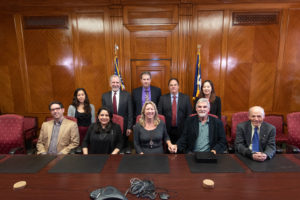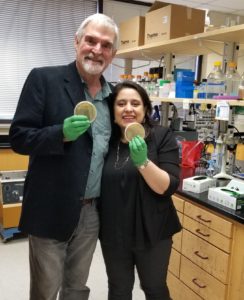Texas A&M University’s Center for Phage Technology to the forefront
Revitalizes treatment opportunities largely unused for nearly a century

COLLEGE STATION — With a major hub of bacteriophage research in College Station, Texas A&M University and Texas A&M AgriLife Research have worked to support and produce the only state-funded bacteriophage research center in the U.S.
Bacteriophage therapy, a treatment using bacterial viruses to treat bacterial infections, has made headway through the years in the field of medicine as a way to potentially reduce dependence upon antibiotic use.
FROM THE START
Nearly 100 years ago, the use of bacteriophage, more commonly referred to as phage, to treat disease was common. Phages are ubiquitous in the environment and are major predators of bacteria in nature.
But antibiotics such as penicillin soon became the go-to product on the market, and bacteriophage became forgotten as a medicine.
Now as humans are faced with antibiotic resistance and the possibility of superbugs, scientists and researchers are looking for alternative therapies, and phage opportunities are returning to the forefront.
Dr. Ry Young, AgriLife Research scientist and director and founding member of the Center for Phage Technology at Texas A&M, has had a nearyear career studying phage biology. He believes increased application of his basic research could change the way doctors apply bacterial therapies in humans.
Young started his research career in phage-based therapeutics. His focus was in veterinary medicine, farm animals and plants because of regulatory issues related to phage applications in humans.
He pursued a year-long sabbatical in 2008 at the Pasteur Institut in Paris to get back to basics working with phage material in the lab. Upon his return to College Station, Texas A&M was hosting an in-house competition challenging faculty across the university to collaborate for new innovative ideas in research. Proposals had to be interdisciplinary and have the potential to raise Texas A&M’s exposure on a national level.
Out of nearly 150 applicants and papers, eight were chosen to be funded with the establishment of the Center for Phage Technology, CPT, being picked as No. 1.
“I think it was picked No. 1 probably because of the simplicity of the idea,” said Dr. Carlos Gonzalez, a CPT founding member and associate director for plant studies at Texas A&M.
In May 2010, the Texas A&M University System Board of Regents officially established the Center for Phage Technology, with the mandate “to position the Texas A&M University System as a world leader in the application of phage to combat bacterial infections in humans, animals and plants, to promote food safety, to protect against potential bacteriological weapons, and to prevent or mitigate the deleterious effects of bacterial contamination, degradation and corrosion in industry,” according to their statement of purpose.
TEXAS A&M AGRILIFE SUPPORT
“Texas A&M AgriLife has been our research home,” Young said. “In every aspect of major support and in every way, both administratively and in terms of space. AgriLife agreed to put in two other laboratories, and by having us all in the same building complex, it has made a big difference.”
Gonzalez credits Dr. Mark Hussey, former Texas A&M vice chancellor and dean for the College of Agriculture and Life Sciences, for his move into the biochemistry department from plant pathology.
“AgriLife has been instrumental in the backing of the CPT and certainly most supportive of it,” Gonzalez said. “That was an important step in supporting us because it put us together as a group and has been very instrumental in the success of the CPT.”
THE PHAGE HUNT
Dr. Steffanie Strathdee, associate dean of global health sciences at the University of California San Diego, approached the CPT about her husband Tom Patterson’s fight for life due to an Acinetobacter baumannii infection in 2016. At the time, there was no effective treatment, and the CPT team was unaware of their actual ability to help due to potential legal limitations.
But, it did not deter them from trying.
“I think we didn’t really appreciate that there was such a thing as emergency uses and compassionate use,” said Dr. Jason Gill, CPT founding member and executive associate director.
The CPT can’t deal with the public directly for these types of situations, Gill said, but this time CPT had been approached by a team of doctors from a large research institution that could actually affirm that the CPT could make an experimental treatment in the lab and give it to someone.
So the hunt was on to find the correct strain to combat the Acinetobacter baumannii infection that put Patterson in a coma and pummeled his body for months.
The CPT was first to find, isolate, purify and deliver a phage that could be administered to Patterson, Young said. Within a 48-hour period, he woke up from his coma recognizing his oldest daughter.

After a few months, additional rounds of phage therapy, and with a long road to full recovery ahead, Patterson was released from the hospital as the first patient on U.S. soil to be treated successfully with bacteriophage therapy.
WHAT’S HAPPENING NOW
The CPT began with the mission of developing phages for use in agriculture and industry, and that continues to be pursued.
Gonzalez’s lab was the first laboratory to isolate phages for Xylella fastidiosa, a plant pathogenic bacterium that causes Pierce’s Disease, which affects many vineyards.
“When I reported this, a pharmaceutical company contacted me and wanted to help us move this forward and be our partner,” Gonzalez said. “So we began our collaboration about eight and a half years ago.
“We went through greenhouse trials, and we went through trials out in the field,” he said. “The company has licensed the IP from Texas A&M and is in the process of commercializing. The product should be available this summer if the Environmental Protection Agency approves it.”
On the human health side, Gonzalez is concentrating on a bacteria associated with patients who have cystic fibrosis, he said. These are patients infected with a bacteria known as the Burkholderia cepacia complex.
CPT receives cultures from the Center for Innovative Phage Applications and Therapeutics at UC-San Diego, or IPATH, which was formed by Strathdee and others at the university in an effort “to pursue through collaboration, research and companies’ new treatments to combat antimicrobial resistant diseases.”
“And the CPT has the expertise to do this,” Gonzalez said.
His team is currently in the process of finding phages active against cultures received from the U.S., Canada and the United Kingdom.
“This is a worldwide effort,” he said.
Gill, as the animal science-based phage biologist, is focusing his applied research on foodborne pathogens and animal health. His projects cover MRSA, or Staphylococcus aureus, salmonella and pathogenic E.coli, which he researches in his own lab as well as in the CPT laboratories.
“CPT is kind of a shared resource for all the CPT faculty and really anybody who wants to collaborate with the center because we have the lab space, and we have the equipment,” Gill said. “We have people who want to work on phages in their lab, and they want some experience and expertise. We do that as well as operate a bioinformatics infrastructure.”
Gill and Young also co-teach an undergraduate phage genomics class targeting bacteriophage biology and genomics.
WHAT’S NEXT
Since bacteriophage therapy is still in the research phase, the CPT team is looking at ways to make their efforts more feasible as they move forward.
“We are trying to set up now where it would be more sustainable through the center, and that is part of the visit with IPATH, to have a more formal arrangement with them,” Gill said. “So basically, those patients who have multidrug-resistant bacterial infections that might be treatable by phage will contact IPATH. IPATH has a team of infectious disease specialists who now have some phage experience, and they determine if these cases are good candidates for phage.”
If treatable, the call for phages goes out, and the CPT steps up.
“So that is kind of where we are right now, and we are working through a few cases,” Gill said.
Ideas moving forward include generating bills for how much this therapy costs because no one truly knows, Young said. With the therapy being in the emergency-use phase, it cannot actually be charged or paid for, but once it becomes an available treatment the cost will become an issue.
Down the road, there is also an opportunity to build a company that specializes in the purification and stocking of phage banks in hospitals, he said.
In the meantime, the center is always looking for basic research funding.
“A center is only as strong as its academic research departments,” Young said. “And if we can figure out the intellectual property issue, there might be a spinoff at some point.”
For more information about the Center for Phage Technology, visit https://cpt.tamu.edu/.
Writer: Laura Muntean, 979-847-9211, [email protected]
Contact: Center for Phage Technology, 979-845-9427, [email protected]


